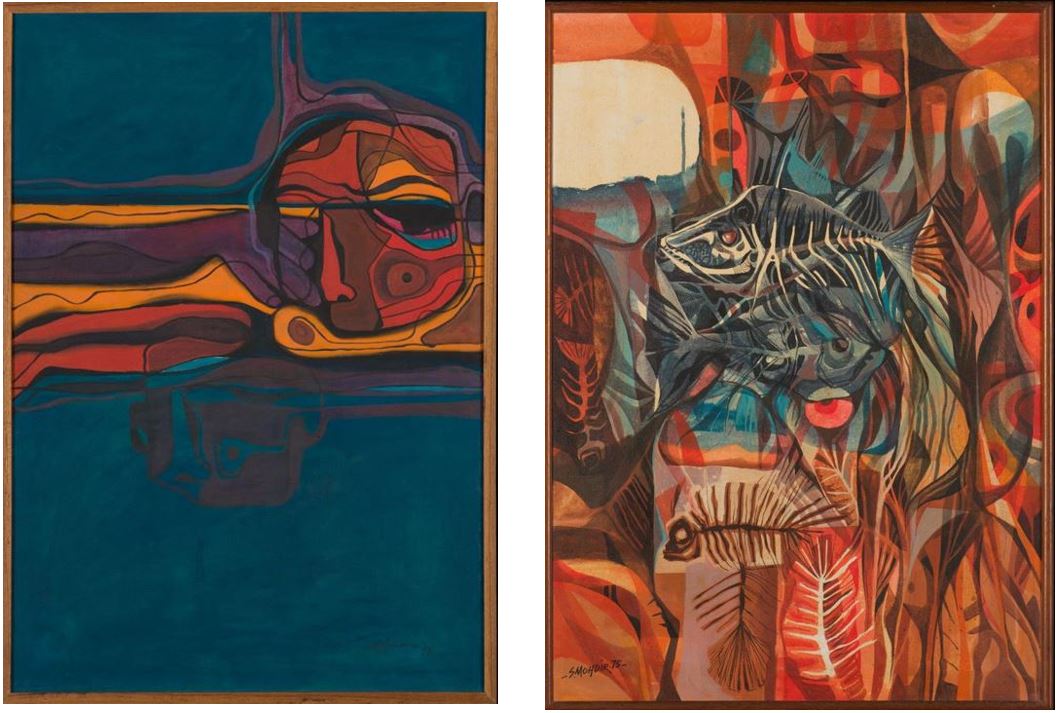Creative Collectives: Abdul Ghani Abdul Hamid and His Contemporaries
Nadia Ramli traces the history of the Malay art scene in early Singapore through a collection of art-related ephemera, catalogues and publications at the National Library.
(Right) S. Mohdir’s “Dalam” (1975), which means “deep” in Malay, depicts the unexplored depths of the world beneath the sea. This work has often been cited as an example of an early experimentation in surrealism by a Singaporean artist. Courtesy of National Gallery Singapore.
In April 1948, an art exhibition held at the Y.M.C.A. Singapore was reported in The Morning Tribune as “the first occasion of the Malay Artists of Singapore holding an Exhibition of Art”.1 The event, helmed by the Singapore Malay Art Class, was organised by C. Mahat (Mahat bin Chadang),2 a pioneering Malay artist who had been nurturing budding talent through his art classes since 1947.
Early Malay Art Groups
In 1949, C. Mahat and another artist, M. Salehuddin, set up the Persekutuan Pelukis Melayu Malaya (PPPM, or the Society of Malay Artists, Malaya).3 This marked the beginning of a collective effort by Malay artists to establish themselves in Singapore’s visual arts scene.
The society held its first show at the British Council Hall in February 1951, showcasing a total of 197 artworks on themes such as Malayan scenery, occupations and events. A Straits Times article, titled “Paintings of Nadra on Show”4, highlighted two oil paintings that depicted Maria Hertogh, the Dutch teenager who sparked a series of racial riots5 in December the previous year. (Hertogh was given the name Nadra upon her conversion to Islam.)
In the 1950s, other art collectives and groups emerged, albeit mostly short-lived. In 1956, the Angkatan Pelukis Muda (Young Artists’ Movement) emerged on the scene, founded by a group of aspiring young artists, but it was unable to garner sufficient support and dissolved soon after.6 Subsequently, in January 1960, a few artists and art enthusiasts came together to form Tunas Pelukis ’60 (Budding Artists ’60), with S. Mahdar as mentor.7 The latter was known back then for the naturalism and realism in his art.8
In April 1961, the art section of Lembaga Tetap Kongres Bahasa dan Kebudayaan Melayu (LTK; Permanent Board of Congress of Malay Language and Culture) staged a major exhibition at the Victoria Memorial Hall. The exhibition featured the works of 34 Malay artists, both experienced as well as amateur artists. The souvenir publication for the event included photographs of selected works, including that of established artists such as C. Mahat, Sulaiman Haji Suhaimi, M. Salehuddin, M. Sawoot, Aman Ahmad, and younger artists like Abdul Ghani Abdul Hamid, S. Mohdir, S. Mahdar and Rohani Ismail.9
The LTK continued to promote art and cultural activities in the following years, with its festivals in 1963 and 1968 providing platforms to exhibit the works of budding artists.10 In its 1968 cultural festival souvenir publication, Abdul Ghani Abdul Hamid wrote that an “exhibition of paintings such as this is one of the many ways of introducing the artist and his works to the public”.11
The call for an art society for Malay artists eventually culminated in the formation of the Angkatan Pelukis Aneka Daya (APAD; Association of Artists of Various Resources) in July 1962. APAD was led by Abdul Ghani Abdul Hamid, Muhammad Ali Sabran, S. Mohdir, Ahmin Haji Noh, Hamidah M. F. Suhaimi and Mustafa Yassin.12 The association became active in organising solo and group exhibitions, and also took part in collaborations with other cultural groups, art societies and art galleries, both in Singapore and the region. APAD continues to exhibit works by Malay artists today, making it one of the few art societies in Singapore that have survived the test of time.
Nurturing Young Talent
Before formal arts education became widely accessible to the community (the pioneering Baharuddin Vocational Institute was opened only in 1965), classes run by individual artists and art societies provided the only means of learning art outside of schools. Seeing the importance of art education and building a learning community, APAD organised outings to draw or paint as well as overseas study tours to Kelantan, Kuala Lumpur and Malacca, in addition to its series of children’s art classes and programmes aptly named TUNAS (Sprouts). These efforts created an awareness of Malay artists and their works, and also expanded their network within the local and regional art communities.13
In July 1964, APAD launched its formal art classes. Details of the syllabus and curriculum are found in the information booklet Kelas Lukis (Art Class).14 Classes for beginners taught students still life and the use of pencil and charcoal, while more advanced classes included portraiture drawing as well as watercolour and oil painting. The association also conducted classes for art students sitting for their GCE O-Level art examination.
Art education also came by way of books. Two landmark publications – one published in 1949 and the other in 1960 – helped to generate interest in visual arts among the Malay community. The first is C. Mahat’s Petua Melukis (Tips on Drawing).15 Written in Jawi, Petua provides instructions on sketching and painting, with notes and diagrams for the beginner on how to draw perspectives, create shadows and depths, and sketch basic figures and animals.
The second publication is Abdul Ghani Abdul Hamid’s Sa-kilas Pandang Seni Lukis dan Perkembangannya (A Glimpse of the Arts and its Development). Chapters in the book include discussions on Eastern versus Western art as well as the development of the arts among the Malay community in Singapore and the region. Advertisements that appeared in Berita Harian in 1961 and 1966 marketed it as the first Malay-language book to cover an in-depth study of the art scene in Singapore.16
Here is a glimpse of exhibition catalogues and collaterals – published between the 1960s and 90s – from the collection of the National Library.
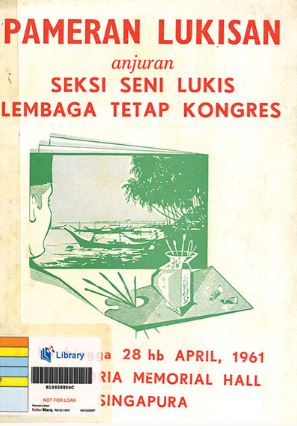 Lukisan Anjuran Seksi Seni Lukis Lembaga Tetap Kongres (1961) Lukisan Anjuran Seksi Seni Lukis Lembaga Tetap Kongres (1961)The souvenir publication of reportedly the largest-scale exhibition featuring Malay artists in Singapore held in April 1961. The event was organised by Lembaga Tetap Kongres Bahasa dan Kebudayaan Melayu (LTK; Permanent Board of Congress of Malay Language and Culture). The back cover features a poem by Abdul Ghani Abdul Hamid titled “Suara!” (Voice!). |
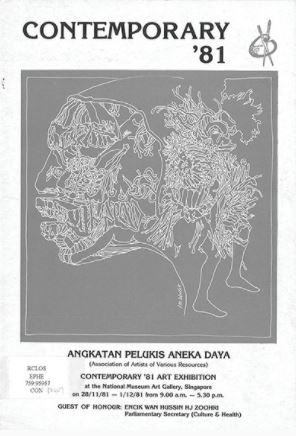 Contemporary ’81 (1981) Contemporary ’81 (1981)This is one of the many contemporary arts exhibitions organised by Angkatan Pelukis Aneka Daya (APAD; Association of Artists of Various Resources). The cover features a work by pioneering artist Ismail Muda (Ibrahim Bin Muda). The late artist also conducted art classes, including graphic art courses, introduced by APAD in the 1980s. |
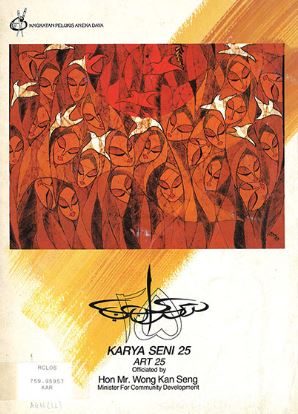 Karya Seni 25 (1988) Karya Seni 25 (1988)In celebration of the 25th anniversary of APAD, this souvenir catalogue showcases a selection of exhibited artworks and their creators. The front cover features the artwork “Searching for Peace” by Sujak Rahman. He is regarded as one of the finest batik painters in Singapore and is known for his “Mother & Child” series of artworks. Also known in Japan, Sujak won the first prize at the Hokkaido International Cultural Exchange Award (1986) and had his works exhibited in Japan from 1984 to 1988. Apart from batik, Sujak also works with other medium such as acrylic and oil. |
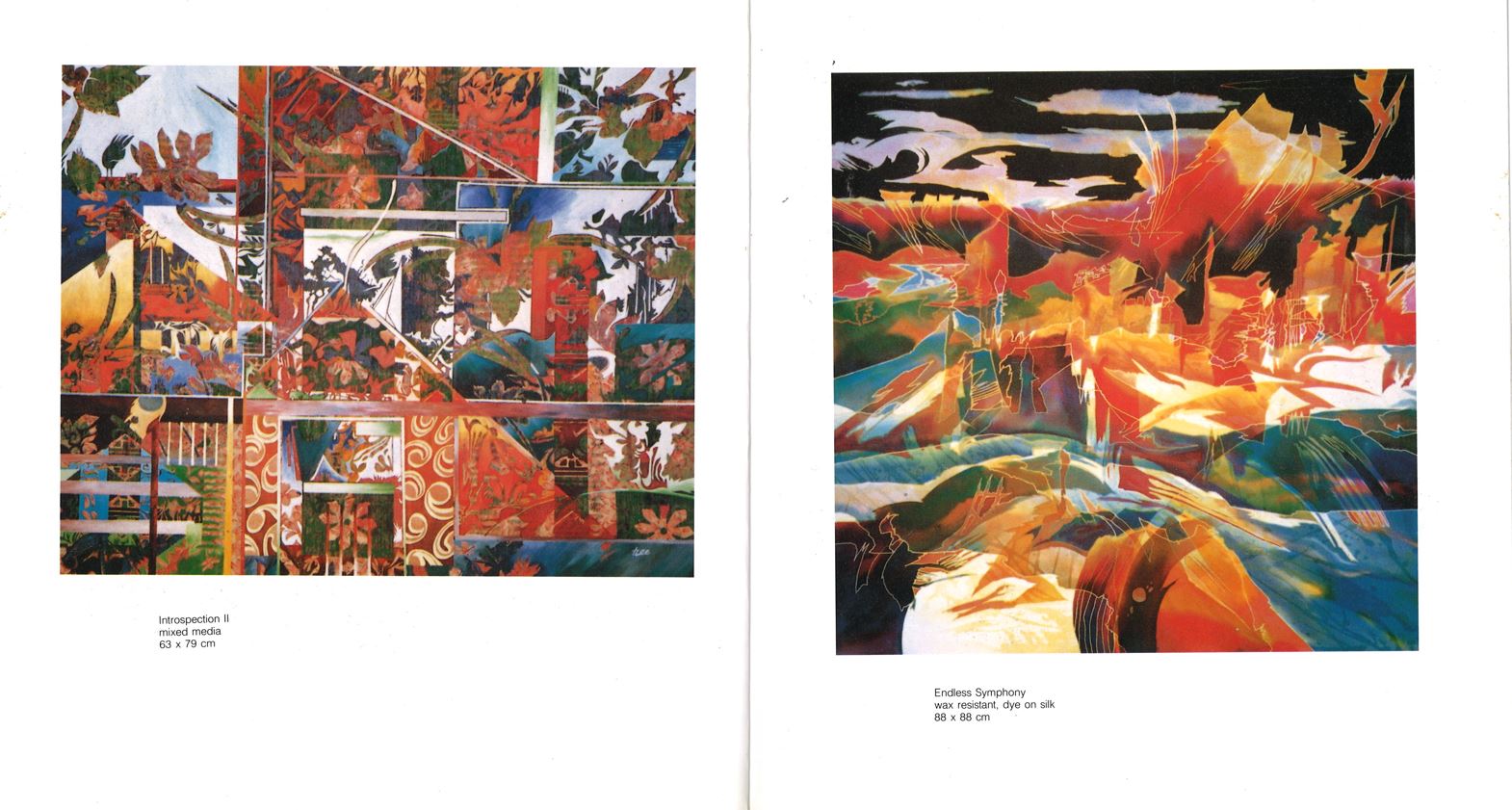 Introspection (1991) Introspection (1991)This is a catalogue of Sarkasi Said’s (Tzee) solo exhibition “Introspection”, held at the National Museum Art Gallery, Singapore, in 1991. As a batik painter, Tzee is well known for his works on silk that use mixed-media, acrylic and dye. The catalogue includes an introduction by art historian, T. K. Sabapathy. |
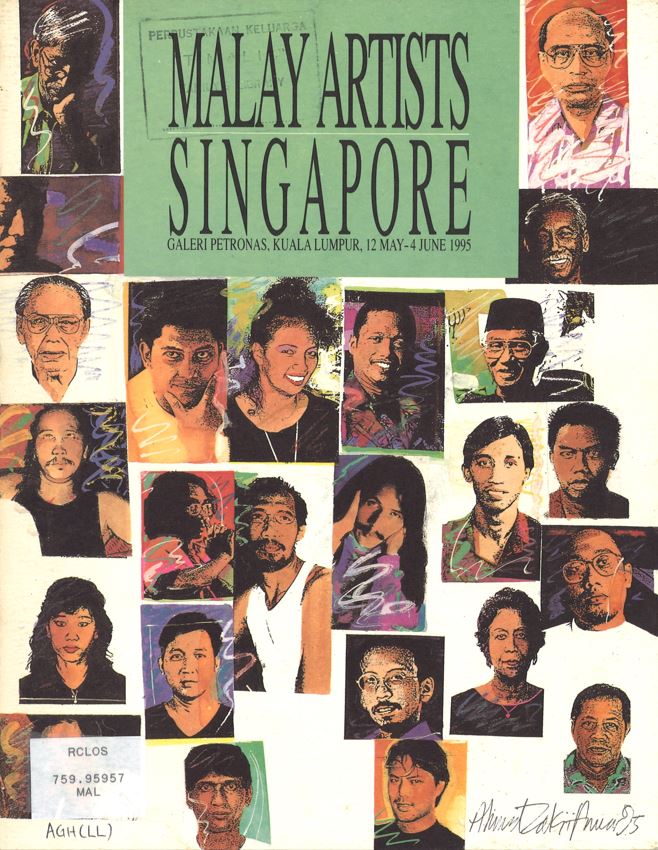 Malay Artists Singapore (1995) Malay Artists Singapore (1995)N. Parameswaran, the organiser and curator of this exhibition held at Galeri Petronas in Kuala Lumpur, Malaysia, in 1995 wrote in the introduction of the publication that it was a “reunion exhibition” of sorts for Singaporean Malay artists and provided an opportunity for them to exhibit their works outside of their usual circles. |
Abdul Ghani Abdul Hamid (1933–2014) was a prolific and award-winning writer, poet and artist. Writing primarily in Malay, he penned hundreds of poems, short stories, essays, newspaper articles and plays in his lifetime. His series of abstract paintings, “Lalang”, were the most famous in his oeuvre.
Abdul Ghani was an active member of the literary and visual arts scenes in Singapore. He was a founding member of Angkatan Pelukis Aneka Daya (APAD; Association of Artists of Various Resources) and served as its president between 1962 and 1983. He was also a member of the National Arts Council from 2000 to 2002 and the recipient of three prestigious literary awards: Anugerah Tan Seri Lanang (1998), Southeast Write Award for Malay Poetry (1998) and the Cultural Medallion (1999).
The Abdul Ghani Abdul Hamid Collection at the National Library comprises letters and literary manuscripts as well as publications and ephemera related to the visual and literary arts. Included in the collection are letters and notes that document Abdul Ghani’s involvement with art associations, exhibitions and various events in Singapore.
Catalogued by subject matter and time period, the collection provides rich insights into the development of the Malay visual arts scene in Singapore.
 Portrait of Abdul Ghani Abdul Hamid. All rights reserved, Eric Foo Chee Meng 1979–2001. Courtesy of National Arts Council.
Portrait of Abdul Ghani Abdul Hamid. All rights reserved, Eric Foo Chee Meng 1979–2001. Courtesy of National Arts Council.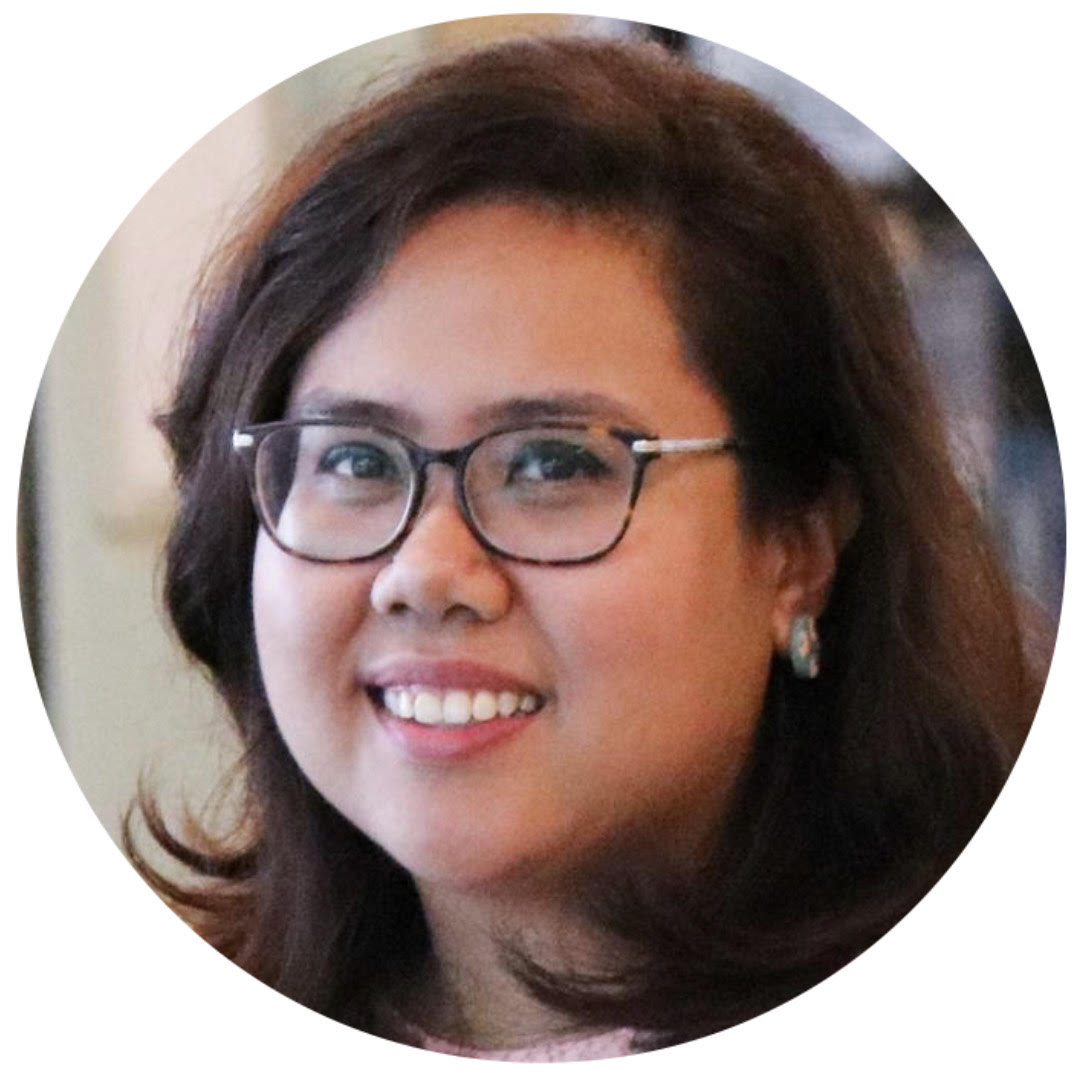 Nadia Arianna Ramli is an Associate Librarian with the National Library, Singapore. She works with the library’s arts collections, with a special focus on literary and visual arts. Her research interests include Singapore literature and theatre studies.
Nadia Arianna Ramli is an Associate Librarian with the National Library, Singapore. She works with the library’s arts collections, with a special focus on literary and visual arts. Her research interests include Singapore literature and theatre studies.References
National Library Board. (2014). Abdul Ghani Abdul Hamid written by Nureza Ahmad & Shah Alam bin Mohd Zaini. Retrieved from Singapore Infopedia.
Syed Muhd Hafiz. (2012). Semangat APAD: The pioneering generation. In. Our pioneer artists: Malay visual art practices from post-war period (p. 7). Singapore: Angkatan Pelukis Aneka Daya. (Call no.: RSING 759.95957 OUR)
Notes
-
Malay art on view Friday. (1948, April 14). The Morning Tribune, p. 3. Retrieved from NewspaperSG. ↩
-
The Morning Tribune, 14 Apr 1948, p. 3; Syed Muhd Hafiz. (2012). Semangat APAD: The Pioneering Generation. In Our pioneer artists: Malay visual art practices from post-war period (p. 4). Singapore: Angkatan Pelukis Aneka Daya. (Call no.: RSING 759.95957 OUR) ↩
-
Ahmad Mashadi. (1995). The study of Singapore Malay art. Some issues and problems. In Malay artists Singapore: An exhibition (n.p.). Kuala Lumpur: N. Parameswaran. (Call no.: RCLOS 759.95957 MAL) ↩
-
Abdul Ghani Hamid. (1990). Kegiatan kolektif pelukis-pelukis Melayu (p. 2). Singapore: Angkatan Pelukis Aneka Daya. (Call no.: Malay RSING 759.95957 ABD); Abdul Ghani Hamid. (1991). An artist’s note (pp. 7–8). Singapore: Angkatan Pelukis Aneka Daya. (Call no.: RSING 759.9597 ABD); Paintings of Nadra on show. (1951, February 12). The Straits Times, p. 5; Malay art society plans show. (1951, February 2). The Straits Times, p. 8. Retrieved from NewspaperSG. ↩
-
The Maria Hertogh riots took place in Singapore in December 1950 when the court ruled that 13-year-old Dutch teenager Maria, who had been raised by her adoptive Muslim parents, should be returned to her Catholic biological parents. ↩
-
Mohd Raman Daud. (2013). Artist’s sketches: The Malay fine art movement in postwar Singapore (Syed Muhd Hafiz, Trans). In Moving on: An art exhibition of small works by member of APAD, 3–10 October 2013 (p. 11) Singapore: Angkatan Pelukis Aneka Daya. (Call no.: RSING 709.5957 MOV) ↩
-
Abdul Ghani Hamid. (1960). Sa-kilas pandang seni lukis dan perkembangannya (p. 65). Singapore: Pustaka Melayu. (Call no.: Malay RSING 750 ABD) ↩
-
S. Magiar Simen. (1961, November 5). Pelukis muda (modern arts ta’ sa-suai) akan ka Tokyo. Berita Harian, p. 6; Iryani Jayadi. (1960, June 2). Tunas selukis ’60. Berita Harian, p. 4; Panorama. (1961, May 1). Mengapa pergolakan tanah ayer tidak di-abadikan? Berita Harian, p. 4. Retrieved from NewspaperSG. ↩
-
Abdul Ghani Hamid. (2002, January 10). Renungan masa silam bantu kita lebih memahami diri kita hari ini. Berita Harian, p. 11. Retrieved from NewspaperSG. ↩
-
Angkatan Pelukis Aneka Daya. (1997). Karya seni 35: Art 35 (n.p.). Singapore: Angkatan Pelukis Aneka Daya. (Call no.: RART 759.95957 KAR) ↩
-
Lembaga Tetap Kongres (Singapura). (1968). LTK menganjorkan pesta budaya LTK ’68 = LTK cultural festival ’68 dan pameran lukisan (n.p.). Singapore: Lembaga Tetap Kongres. (Call no.: Malay RCLOS 394.26959 LTK-[CUS]) ↩
-
Syed Muhd Hafiz, 2013, p. 12; Abdul Ghani Hamid, 1995, n.p. ↩
-
Angkatan Pelukis Aneka Daya. (1981). Activities in brief. In Contemporary ’81 (n.p.). Singapore: Angkatan Pelukis Aneka Daya. (Call no.: RCLOS 759.95957 CON); Angkatan Pelukis Aneka Daya, 1997 (n.p.); Syed Muhd Hafiz bin Syed Nasir. (2016). Visual arts development within the Malay community (p. 502). In Majulah!: 50 years of Malay/Muslim community in Singapore, (pp. 499–515). Singapore: World Scientific. (Call no.: RSING 305.697095957 MAJ) ↩
-
Angkatan Pelukis Aneka Daya. (1964.). Kelas lukis [booklet]. Singapore: Angkatan Pelukis Aneka Daya. (Call no.: RCLOS EPHE 028 V1.5) ↩
-
C. Mahat. (1949). Buku petua melukis: Penggal pertama (pp. 9, 12, 36, 39–40). Singapore: Suluh Pengetahuan. (Call no.: Malay RCLOS 741.2 MAH); Syed Muhd Hafiz, 2012, pp. 5–6. ↩
-
Advertisement: Sa-kilas Pandang Seni Lukis dan Perkembangannga (1961, August 22). Berita Harian, p. 4; Advertisement. (1966, June 16). Berita Harian, p. 4. Retrieved from NewspaperSG. ↩


